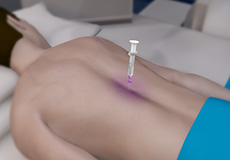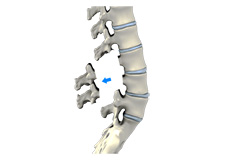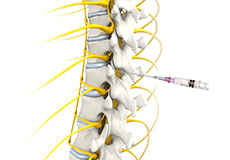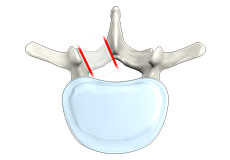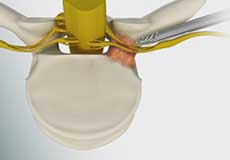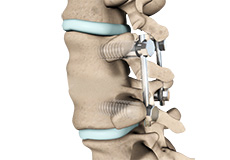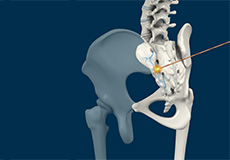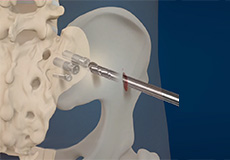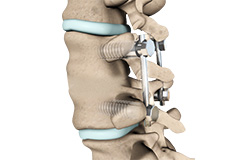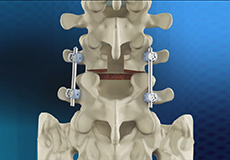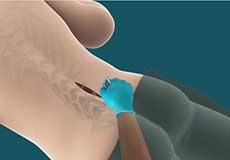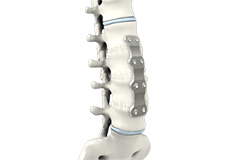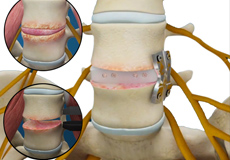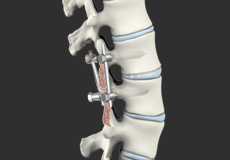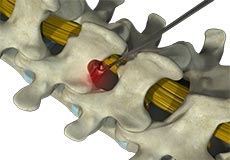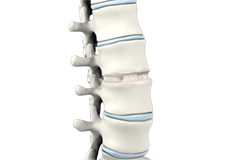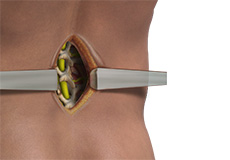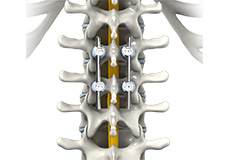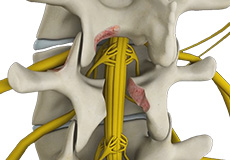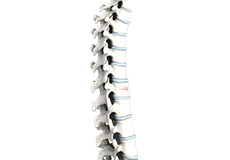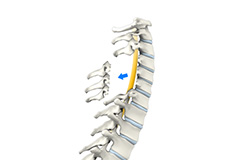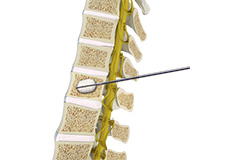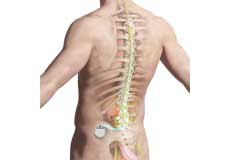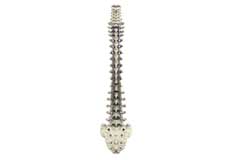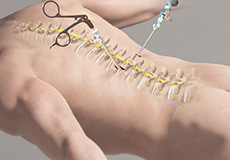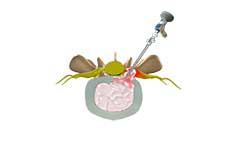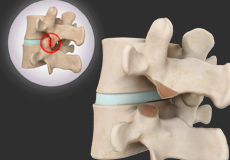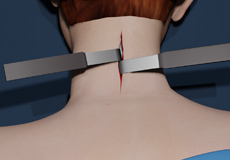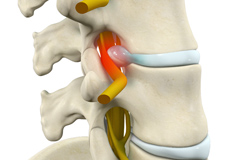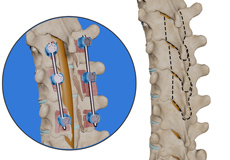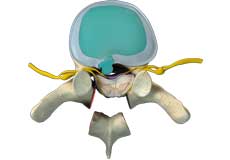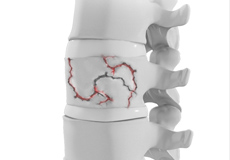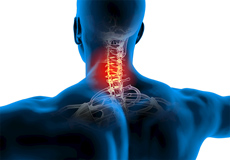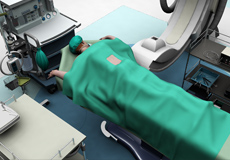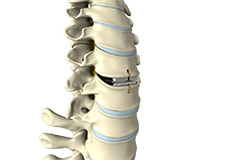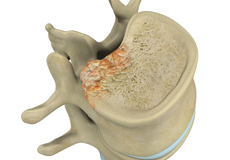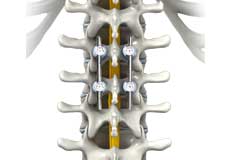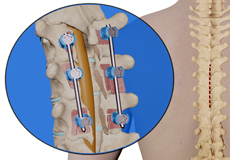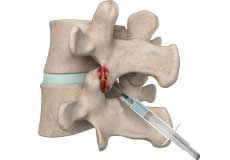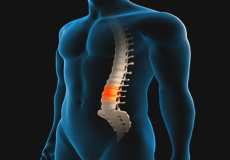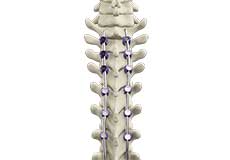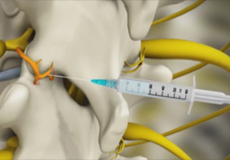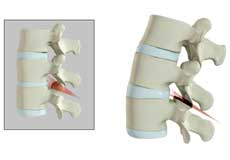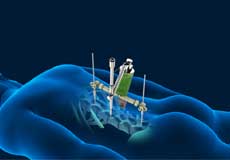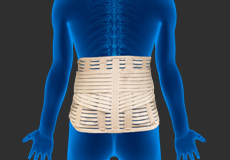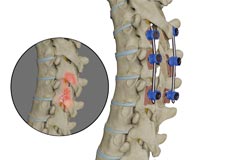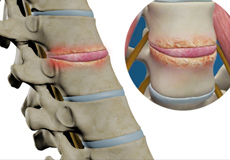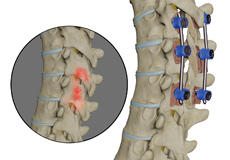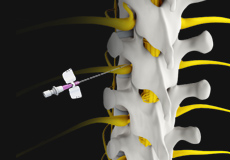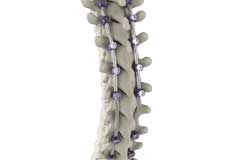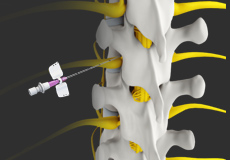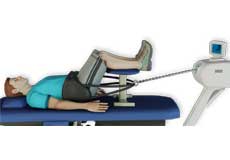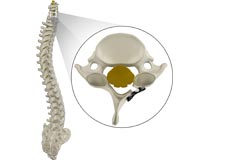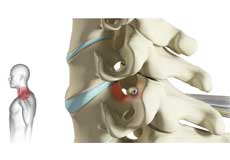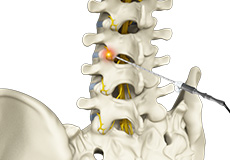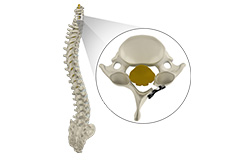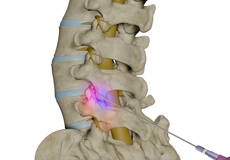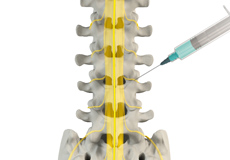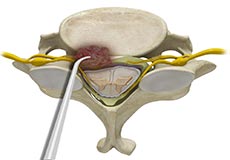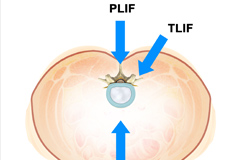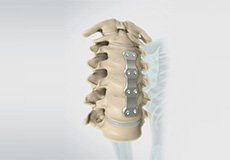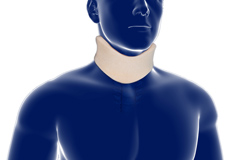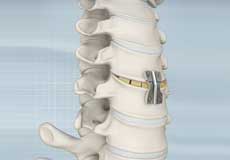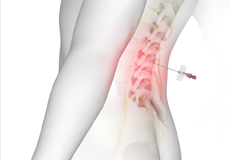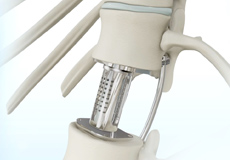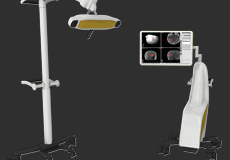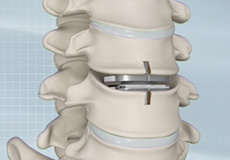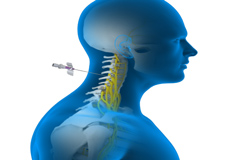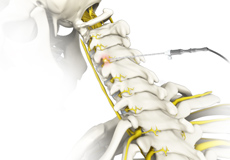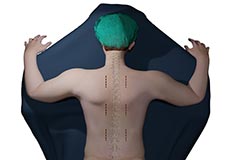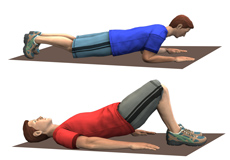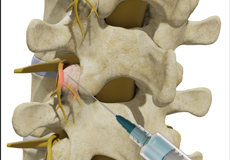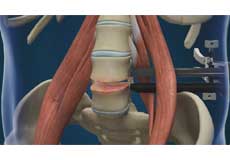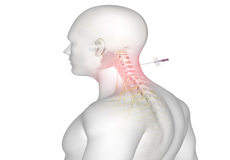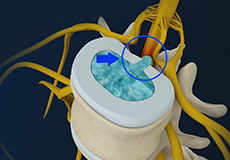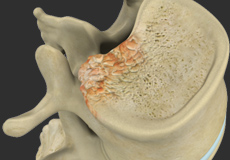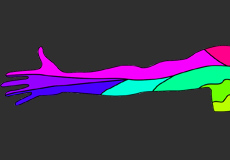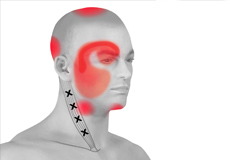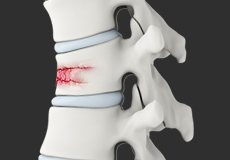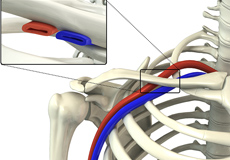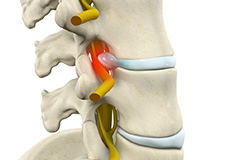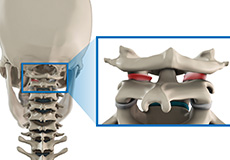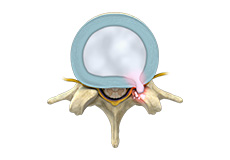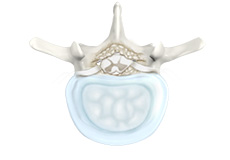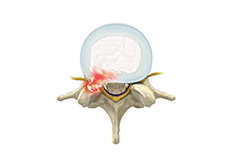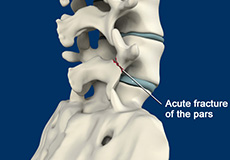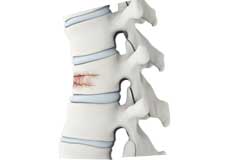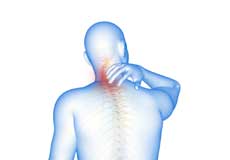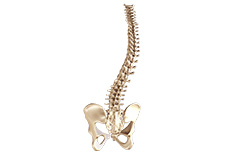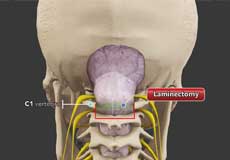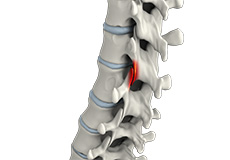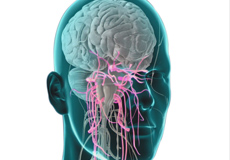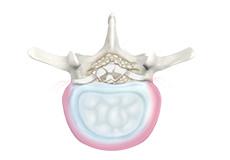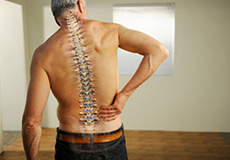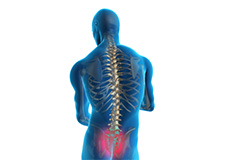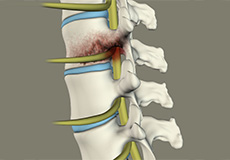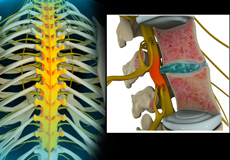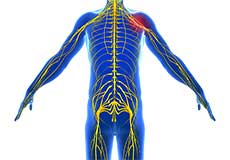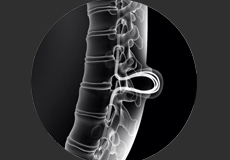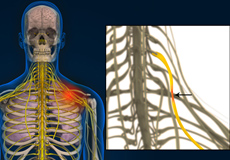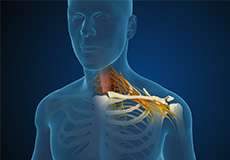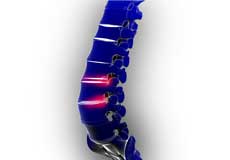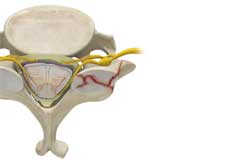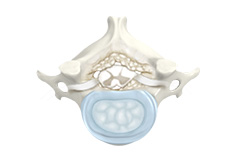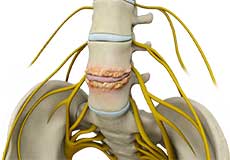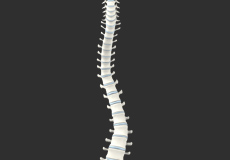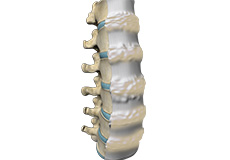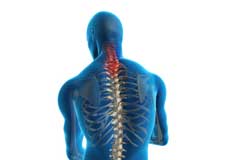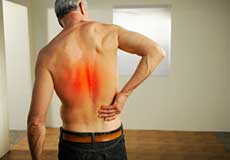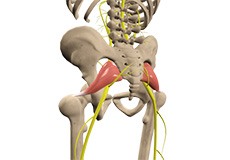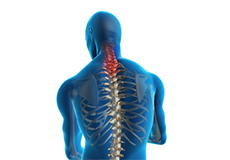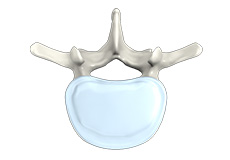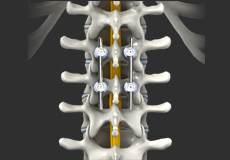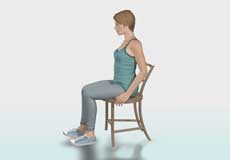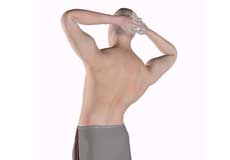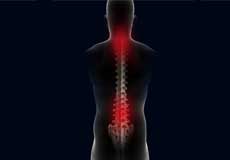Epidural Spinal Injection
Epidural spinal injection is a non-surgical treatment option utilized for relieving back pain. Spine degenerative conditions such as herniated disc, spinal stenosis and many others may induce back pain due to the compression of the associated spinal nerves. This pain or numbness may extend to the other parts of the body such as hips, buttocks, and legs. Doctors start with non-surgical methods to treat back pain and epidural spinal injection is one of these preferences. In cases where the patient finds no relief from non-surgical methods then finally surgery is recommended.
Lumbar Laminectomy
Lumbar laminectomy is a spinal surgery to relieve excess pressure on the spinal cord or nerves within the spinal canal in the lumbar or lower back region. The pressure may be caused by bony overgrowths, herniated discs, injury, tumors, or narrowing of the spinal canal resulting in painful symptoms affecting a person’s ability to perform normal day to day activities.
Epidural Steroid Injections
Epidural steroid injection (ESI) is a minimally invasive approach to treat inflammation of spinal nerves that causes pain in the neck, arms, back and legs. This technique may help relieve back pain in conditions such as spinal stenosis, spondylolysis or herniated discs. In this technique, the steroidal medications are injected into the spinal canal so as to pass down to the inflamed spinal nerve through the epidural space which lies between the covering of the spinal cord and the vertebrae. An ESI contains a corticosteroid medication along with an anesthetic agent which can reduce the inflammation and pain.
Lumbar Foraminotomy
A lumbar foraminotomy is a surgical procedure that decompresses the spinal nerves by removing bone and other tissues that obstruct the neural foramen.
Foraminoplasty
Neural foramina are small canals at every level of the spine through which nerves leave the spinal cord and go to the limbs and other parts of the body. Narrowing of this canal is called foramina stenosis. The narrowing may be caused by bone spurs, a herniated or bulging disc, arthritis, ligament thickening or enlargement of a joint in the spinal canal.
Lumbar Fusion
Spinal fusion, also called arthrodesis, is a surgical technique used to join two or more vertebrae (bones) within the spine. Lumbar fusion is the procedure of fusing the vertebrae in the lumbar portion of the spine (lower back). A piece of bone, taken from other parts of the body or donated from a bone bank is transplanted between the adjacent vertebrae. Screws, plates, or cages may be used with the bone graft to help hold the spine.
Sacroiliac Joint Radiofrequency Ablation
Spinal fusion, also called arthrodesis, is a surgical technique used to join two or more vertebrae (bones) within the spine. Sacroiliac Joint Radiofrequency Ablation is the procedure of fusing the vertebrae in the lumbar portion of the spine (lower back). A piece of bone, taken from other parts of the body or donated from a bone bank is transplanted between the adjacent vertebrae. Screws, plates, or cages may be used with the bone graft to help hold the spine.
How to prevent Back Pain
Back pain is common and usually affects everyone at some point. It often occurs more frequently as you grow older. Pain can either be sharp and sudden or dull and constant. Acute back pain lasts a few days or weeks while pain that lasts more than 6 months is considered chronic.
Sacroiliac Joint Minimally Invasive Fusion
Sacroiliac (SI) joints are joints in the lower back region, where the sacrum and ilium bones join. Although these joints are small and have limited motion, they play an important role in connecting your spine to the pelvic bone and lower part of your body. They perform an important function in absorbing shock from the upper portion of your body.
Posterior Lumbar Fusion
Spinal fusion, also called arthrodesis, is a surgical technique used to join two or more vertebrae (bones) within the spine. Lumbar fusion is the fusion the vertebrae in the lumbar portion of the spine (lower back).
Posterolateral Lumbar Fusion
Posterolateral lumbar fusion is a surgical technique that involves correcting spinal problems from the back of the spine by placing bone graft between segments in the back and leaving the disc space intact.
Lower Back (Lumbar) Surgery
Lower back pain is one of the most common health problems experienced by most individuals, at different phases of their lives.
Lumbar Corpectomy and Fusion
Lumbar corpectomy and fusion is a surgical technique performed to remove the vertebral bone or disc material between the vertebrae to alleviate pressure on the spinal cord and spinal nerves (decompression) in the lumbar (lower back) region.
Lateral Lumbar Interbody Fusion
The back is made up of a number of small bones called vertebrae. Cushioning discs present between the vertebrae act as shock absorbers. The vertebral column allows the cylindrical bundle of nerve fibers called the spinal cord to pass through the entire column length and branch out to the various parts of the body.
Lumbar Interbody Fusion
Lumbar interbody fusion (LIF) surgery is a surgical technique that involves the removal of a damaged intervertebral disc and the insertion of a bone graft into the disc space created between the two adjoining vertebrae. Bone grafts promote healing and facilitate fusion. Screws and rods are used to stabilize the spine during the healing process.
Microdiscectomy
The spine is made up of small bony segments called vertebrae. These vertebrae are categorized into cervical or neck vertebrae, thoracic or upper back vertebrae, lumbar or lower back vertebrae, and the sacrum within the pelvis. A cylindrical bundle of nerve fibers called the spinal cord passes through the entire vertebral column and branches out to the various parts of our body.
Anterior Lumbar Interbody Fusion
Anterior lumbar interbody fusion (ALIF) is a surgery performed to correct spinal problems in the lower back. The surgery can be implemented either as an open surgery or minimally invasive technique.
Minimally Invasive TLIF
Transforaminal lumbar interbody fusion (TLIF) is a minimally invasive fusion of the vertebrae of the lumbar region (lower back). It is designed to provide stability to the spine and treat back and leg pain.
Spinal Fusion
Spinal fusion is the surgical technique of combining two or more vertebrae. A fusion of the vertebrae involves the insertion of secondary bone tissue obtained either from an autograft (tissues from your own body) or allograft (tissues from another person) to enhance the bone healing process.
Spinal Decompression
Spinal decompression is a treatment to relieve pressure on one or many “pinched nerves” in the spinal column. It can be achieved either surgically or by non-surgical methods. Spinal decompression is used to treat conditions that cause chronic backaches such as herniated disc, disc bulge, sciatica, and spinal stenosis.
Vertebroplasty
Vertebroplasty is a minimally invasive procedure performed to reduce or eliminate pain caused by a vertebral compression fracture. It stabilizes the fracture and prevents further collapse of the vertebra, averting deformity.
Laminectomy
Laminectomy refers to the removal or cutting of the lamina (roof) of the vertebral bones to provide space for the nerves to exit from the spine. It can also be performed to relieve the symptoms of the narrowed spinal canal known as spinal stenosis.
Kyphoplasty
Balloon kyphoplasty is a spine surgery that relieves back pain caused by a vertebral compression fracture. The aim of balloon kyphoplasty is to relieve pain, stabilize the fracture and restore the vertebral body height.
Spinal Cord Stimulator
A spinal cord stimulator is a device that sends electrical impulses to the areas of the spinal cord causing pain and interferes with the transmission of pain signals to the brain. It blocks the brain's ability to sense pain in the stimulated areas, thus relieving pain without the side effects that medications can cause.
Spine Deformity Surgery
Spine deformity can be defined as abnormality in the shape, curvature, and flexibility of the spine. When the curves are exaggerated, pronounced problems can occur such as back pain, breathing difficulties and fatigue.
Minimally Invasive Spine Surgery
Minimally invasive spine surgery (MISS) is the latest technology available to perform spinal surgeries through small, less than one-inch-long incisions. It involves the use of special surgical instruments, devices and advanced imaging techniques to visualize and perform the surgery through such small incisions.
Lumbar Microdiscectomy
Microdiscectomy is a surgical procedure employed to relieve the pressure over the spinal cord and/or nerve roots, caused by a ruptured (herniated) intervertebral disc. A herniated disc, common in the lower back (lumbar spine) occurs when the inner gelatinous substance of the disc escapes through a tear in the outer, fibrous ring (annulus fibrosis).
Removal of Facet Joint Cyst
Facet joint cysts, also called synovial cysts, are benign, fluid-filled sacs that develop due to degeneration of the facet joints of the spine. These cysts normally occur in the lumbar spine (lower back) area and may not cause problems, but when large enough, they can cause spinal stenosis or narrowing of the spinal canal leading to compression of the spinal cord or spinal nerves.
Neck Surgery
Neck surgery is a surgical procedure employed for the treatment of neck pain when conservative measures such as physical rehabilitation, medications, and rest have failed to provide any relief to your neck pain.
Lumbar Spinal Fusion
The surgical technique of combining two or more vertebrae is known as spinal fusion. Back pain due to abnormal motion of the vertebrae is treated by this procedure.
Thoracic Discectomy
The human spine provides support to the body allowing you to stand upright, bend, and twist. The spine can be broadly divided into the cervical, thoracic, and lumbar spine. The thoracic spine lies in the mid-back region between the neck and lower back and is protected by the rib cage.
Thoracic Laminectomy
The vertebral column supports the back and protects the spinal cord that runs through it. The nerves that branch out from the spinal cord are also protected and pass through special passages created by each vertebral bone. However, degeneration or herniation (bulging out) of the intervertebral disc that cushions each vertebral bone, injury, bony outgrowths due to arthritis or tumors can compress the spinal cord and nerves, causing debilitating back pain and disability. Nerve compression at the thoracic section of the vertebral column or the chest region can be treated by a surgical technique called a thoracic laminectomy.
Thoracic Spine Decompression
Thoracic spine decompression is a procedure to relieve pressure on the spinal nerves in the middle portion of the back. Spine decompression surgery is indicated in treating spinal stenosis. Spinal stenosis is the narrowing of the spinal canal caused by degeneration of the facet joints and the thickening of the ligaments. These thickened ligaments narrow the spinal canal and compress the nerves causing chronic pain, numbness, and tingling sensation or weakness in your arms or legs.
Thoracic Spine Trauma Surgery
Trauma to the spine can injure the vertebral bones as well as the spinal cord and spinal nerves. Spine trauma is a common injury and may be caused by falls, sports, the low impact falls in the elderly due to osteoporosis, assault, and motor vehicle accidents. Trauma can lead to fractures and dislocations of bones, rupture of ligaments, damage to intervertebral discs, vascular injury, compression of spinal nerves, or bruising or tearing of the spinal cord.
Treatment Options for Back and Neck Pain
Back and neck pain is common symptoms of injury, damage, deformity, or unhealthy spinal conditions. Pain may range from a mild ache to a sharp shooting pain that can spread down your arms and legs. There are many conservative and surgical treatment options that can relieve pain by targeting the symptoms or the underlying problem.
Spine Surgery in Athletes
Spine surgery is an operative procedure performed to correct spinal abnormalities. Athletes can undergo sports injuries to the spine requiring spine surgery. A sports injury is a physical trauma sustained by a direct impact, overuse, or application of greater force than the body can withstand during a sports activity.
Disc Arthroplasty
Disc arthroplasty or artificial disc replacement is a spine surgery to replace a degenerated (deteriorated) disc with an artificial disc. The artificial disc is used to replace the degenerated disc to support the vertebrae while still allowing backward and forward bending, side-to-side bending, and turning.
Spinal Tumor Surgery
A spinal tumor is an abnormal mass of tissue surrounding or found within your spinal cord and/or spinal column.
Posterior Thoracic Fusion
Posterior thoracic fusion is a spinal fusion procedure performed through an incision on the back (posterior) of the patient in which two or more vertebrae of the thoracic spine (mid back) are joined together, eliminating any movement between them. This procedure is performed by placing bone grafts or bone graft substitutes in between the affected vertebrae to promote bone growth and eventually fuse the vertebrae into a single, solid bone.
Thoracic Corpectomy
Thoracic corpectomy is a surgical procedure performed to relieve pressure on a nerve at the thoracic region (upper and middle back) by removing the source of the compression.
Facet Injections
A minimally invasive treatment called facet injection offers symptomatic relief from back pain caused by inflammation of the facet joints; however, this is not a permanent solution for the condition. The objective of the treatment is to suppress pain so that normal activities can be resumed and you can perform physical therapy exercises.
Degenerative Spine Surgery
Degenerative Spine Surgery (DBS) is a neurosurgical procedure performed to control and manage abnormal brain activity symptoms associated with a number of neurological conditions. The procedure involves placement of electrodes into the targeted areas of the brain. These electrodes create electrical signals that regulate abnormal brain activity.
Surgery for Scoliosis
Surgery for scoliosis is recommended when the spinal curvature is severe and is either worsening or is a cause of severe pain or difficulty in breathing. The surgery is aimed at rectifying the spinal curvature, stabilizing the spine and preventing it from worsening.
Medial Branch Block Injections
A medial branch block is an injection of a local anesthetic administered near the medial branch nerves to temporarily block the pain signal carried from the facet joints of the spine to the brain. It assists your doctor in diagnosing the cause of your back pain.
Spine Osteotomy
Spine osteotomy is a surgical procedure in which a section of the spinal bone is cut and removed to allow for correction of spinal malalignment.
Robotic Spine Surgery
Robotic spine surgery is a procedure where your surgeon is assisted by a robotic system to perform surgery to the spine. Precision is very important when performing spine surgery.
Lumbar Spinal Bracing
Lumbar braces are external devices used to restrict the movement of the lumbar spine and provide support and stability to the lower back region, to relieve back pain and promote healing after surgery or injury.
Fracture Stabilisation
A spinal fracture refers to a break in any of the bones that make up the spine. It can occur due to trauma such as a traffic accident, fall from a significant height or weakening of the bones due to osteoporosis or a tumor. The thoracic or lumbar spine (upper and lower back) are the most common locations for spinal fractures.
Spinal Infection Debridement
The spine is made up of bones called vertebrae which surround and protect the spinal cord. These are separated by intervertebral discs which provide cushioning between the vertebral bones. A spinal infection may affect any part of your spine, i.e. the vertebral column, intervertebral discs or the soft tissues surrounding the spine.
Spinal Infection Stabilisation
The spine is made up of many bones called vertebrae which surround and protect the spinal cord. Intervertebral discs between the vertebral bones provide cushioning. A spinal infection may affect any part of the spine including the vertebral column, intervertebral discs or the soft tissues surrounding the spine.
Transforaminal Epidural Steroid Injection
The epidural space of the spine is the area between the vertebral bones and the protective dura sac that surrounds the spinal cord and nerves.
Complex Spinal Surgery
Complex spine surgery is a type of back surgery involving a fusion of six or more vertebrae. The vertebrae are a series of small interlocking bones extending from the skull to the pelvis (hip) to form your spinal column or backbone. Spinal fusion helps in forming a solid bridge of bone that stabilizes your back.
Spine Injections
Spine injection is a non-surgical treatment modality recommended for the treatment of chronic back pain. Injection of certain medicinal agents relieves the pain by blocking the nerve signals between specific areas of the body and the brain. The treatment approach involves injections of local anesthetics, steroids, or narcotics into the affected soft tissues, joints, or nerve roots. It may also involve complex nerve blocks and spinal cord stimulation.
Cervical/Lumbar Traction
Traction or spinal decompression therapy separates the vertebrae and reduces the pressure on the nerves.
Disc Decompression
Acute or chronic injury can cause a spinal disc to herniate or rupture. The damaged disc may compress against the spinal cord or the nerves that branch out through the vertebral bones, leading to pain, loss of sensation and/or motor function in the part of the body supplied by the nerve.
Cervical Laminectomy
Laminectomy refers to the removal or cutting of the lamina (roof) of the vertebral bones to provide space for the nerves to exit from the spine.
Cervical Foraminotomy
Cervical foraminotomy is a surgical procedure performed to relieve the symptoms of a pinched or compressed spinal nerve by enlarging the neural foramen, an opening for the nerve roots to exit the spine and travel through the body. The neural foramen forms a protective passageway for nerves that transmit signals among the spinal cord and the rest of the body parts.
Radiofrequency Ablation
Radiofrequency ablation (RFA), also called rhizotomy or neurotomy, is a novel non-surgical technique of treating pain. This technique employs radiofrequency waves to produce heat and the heat produced damages the nerves transmitting pain signals to the brain. This procedure is performed to treat painful facet joints in the spine that usually cause chronic low back pain and neck pain.
Outpatient Spine Surgery
Outpatient spine surgery is an operative procedure that does not require an overnight stay at the hospital. It is also called ambulatory or same-day surgery. Improvement in surgical techniques, modern pain management, and rehabilitation protocols allows surgeons to perform certain operative techniques of the spine (from cervical to lumbar region), with a minimally invasive technique on an outpatient basis.
Cervical Spine Fusion
Cervical spine fusion is a surgery performed to fuse weak cervical vertebrae with adjacent vertebrae to provide stability and prevent injury to the spinal cord.
Radiofrequency Ablation for Lumbar Spondylosis
Radiofrequency ablation for lumbar spondylosis is a minimally invasive surgical procedure performed to treat lower back pain secondary to lumbar spondylosis. The procedure employs radiofrequency waves to produce heat which damages the nerves transmitting pain signals to the brain in the lumbar spine.
Posterior Cervical Laminectomy and Fusion
Injury or wear-and-tear can cause parts of the cervical vertebrae in the neck region to compress the nerves of the spinal cord, leading to pain, numbness, or tingling in the part of the body that the nerve supplies.
Cervical Laminoplasty
A cervical laminoplasty is an operative procedure that involves reshaping/repositioning the bone at the neck region (cervical spine) to relieve excess pressure on the spinal nerves. It can also be performed to relieve the symptoms of the narrowed spinal canal known as spinal stenosis.
Lumbar Facet Block
A facet block is a procedure in which a combination of a local anesthetic and a corticosteroid is injected into a facet joint. A lumbar facet block prevents the transmission of pain signals from the lower back.
Lumbar Medial Branch Block
A medial branch block is a procedure in which a mixture of a local anesthetic with or without a corticosteroid is injected near the medial branch nerves supplying a facet joint. A lumbar medial branch block prevents the transmission of pain signals from the lower back.
Tumour Decompression
In medicine, decompression is a surgical procedure involving the excision or repositioning of a structure compressing any other structure in your body in order to relieve the pressure.
Minimally Invasive Lumbar Fusion
A minimally invasive lumbar fusion technique is used to treat fractured vertebra, lumbar instability, spine deformities – scoliosis or kyphosis, cervical disc hernias, tumors, back pain, and failed back syndrome. Spondylolisthesis, a painful condition of the spine caused by disc displacement or slipped disc, can be treated with minimally invasive lumbar fusion technique.
Anterior Cervical Corpectomy and Fusion
An anterior cervical corpectomy and fusion is an operative procedure to relieve pressure on the spinal cord and spinal nerves by removing the vertebral bone and intervertebral disc material (decompression) in the cervical spine or neck.
Cervical Corpectomy and Strut Graft
A cervical corpectomy and strut graft is a surgical procedure aimed at relieving the compression on the spinal cord by removing the degenerated vertebrae and replacing them with a bone graft.
Cervical Bracing
Cervical braces are external devices used to provide support and restrict movement of the cervical spine in a variety of cervical conditions ranging from muscle spasm to severe spine instability or post-surgery. Braces are also called orthotics and are made from different materials such as nylon, rubber, moulded plastic and elastic cotton.
Anterior Cervical Discectomy with Fusion
Anterior cervical discectomy with fusion is an operative procedure to relieve compression or pressure on nerve roots and/or the spinal cord due to a herniated disc or bone spur in the neck. The vertebra is approached from the from (anterior) of your neck.
Lumbar Epidurals
Lumbar epidurals are injections to treat and relieve low back pain. A lumbar epidural involves injecting a local anesthetic and an anti-inflammatory steroid into the epidural space of the lower spine (lower back) to reduce inflammation causing the pain.
Thoracic Vertebroplasty
Thoracic vertebroplasty is a minimally invasive procedure performed to reduce or eliminate pain caused by vertebral compression fractures. It stabilizes the fracture and prevents further collapse of the vertebra, averting deformity.
Non-Surgical Spine Treatments
Non-Surgical Spine Treatments is a minimally invasive procedure performed to reduce or eliminate pain caused by vertebral compression fractures. It stabilizes the fracture and prevents further collapse of the vertebra, averting deformity.
Computer-Assisted Spine Surgery
Computer-assisted spine surgery is an instrument tracking technology in which the surgical instruments are viewed with the help of three-dimensional images of the spine. This technology increases the accuracy and safety of the spinal procedures which cannot be achieved with traditional spinal surgical approaches.
Cervical Disc Replacement
The cervical spine is located in the neck region and consists of seven bones arranged one on top of the other. Cushioning tissue called vertebral discs located between the vertebrae act as shock absorbers, allowing easy movement of the neck.
Spinal Nerve Blocks
A spinal nerve block is the injection of an anesthetic and steroid medication around the spinal nerve root to diagnose or treat pain.
Cervical Microdiscectomy
Your spine consists of 24 bones called vertebrae that are arranged one above the other and separated by intervertebral discs which act as shock absorbers during activity. Your neck or cervical area is made up of seven of these vertebrae. The intervertebral discs consist of 2 parts, namely annulus fibrosus (outer flexible ring) and nucleus pulposus (central soft jelly-like region).
Spinal Facet Rhizotomy
Spinal facet rhizotomy is a minimally invasive procedure to destroy nerves that transmit pain impulses from the facet joints of the spine.
Minimally Invasive Scoliosis Surgery
The goal of scoliosis surgery is to both reduce the abnormal curve in the spine and to prevent it from progressing further and getting worse. To achieve this, a spinal fusion is performed to fuse the vertebrae, in the curve to be corrected.
Physical therapy for the Spine
Physical therapy is one of the foremost necessary treatment modes of recovery for back pain. A referral to physiotherapy sometimes is created by your spine surgeon. A physical therapist is a well-trained, skilled health care professional who facilitates improving movement and manages the pain by safe stretching, conditioning, and strengthening exercise techniques.
Thoracic Facet Joint Injection
Facet joints are small joints present between the vertebral bones including the vertebral bones of the thorax (upper back). The bones in these joints are covered by cartilage and a capsule filled with synovial fluid surrounds the joint reducing friction. Thoracic facet joints can be affected by injury, mechanical stress or arthritis causing pain in the mid-back, chest and rarely the arms.
Lumbar Discectomy
A lumbar discectomy is a surgical procedure performed to treat a herniated or ruptured disc and relieve pressure on the spinal nerves.
Cervical Epidurals
A cervical epidural is an injection of medication into the epidural space in the lower section of the cervical region to provide relief from pain or inflammation affecting the neck and upper back. The epidural space is the space between the outermost covering of the spinal cord (dura mater) and the wall of the spinal canal and runs along the length of your spinal cord. It is approximately 5 mm wide and is filled with spinal nerve roots, fat, and blood vessels.
Herniated Disc (Lumbar)
Herniated disc is a condition in which the outer fibers (annulus) of the intervertebral disc are damaged causing the soft inner material of the nucleus pulposus to rupture out of its space. A herniated disc, common in the lower back (lumbar spine) occurs when there is a tear in the outer lining of the disc (annulus fibrosus). This causes the inner jelly-like material (nucleus pulposus) to leak out and place pressure on the adjacent spinal nerve root. It is the most common cause of lower back pain and pain that radiates down the leg (radiculopathy).
Benign Spinal Tumors
The spinal cord is a long bundle of nerves that extends from the brain along the length of the spinal column. The spinal cord is protected by the surrounding vertebrae and three membranes called the meninges. Spinal tumors are the result of abnormal, uncontrolled growth of tissues or cells in the spinal cord.
Arm Pain of Spinal Origin
Arm pain of spinal origin can be described as discomfort or pain felt anywhere in the arm including the wrist, elbow, or shoulder as a result of a pinched nerve (nerve compression) or irritated nerve in the spinal cord. The pain can occur as a dull constant pain or a sudden sharp pain that can develop suddenly or over time. The pain may be confined to one area of the arm or may radiate to other areas of the arm such as the hand, wrist, elbow, or shoulder.
Cervicogenic Headache
Cervicogenic headaches involve pain in one or both sides of your head that radiates from your neck to the front of the head.
Spinal Fractures
Vertebral compression fractures occur when the normal vertebral body of the spine is squeezed or compressed. The bone collapses when too much pressure is placed on the vertebrae, resulting in pain, limited mobility, loss of height, and spinal deformities.
Thoracic Outlet Syndrome
The thoracic outlet is a small passageway leading from the base of the neck to the armpit and arm. This small area contains many blood vessels, nerves, and muscle.
Lumbar Radiculopathy
Back pain is a common condition affecting approximately 80% of the population at some point in their lives. The area usually affected is the lower back (lumbar region) as it bears most of the upper body’s weight. Trauma to the spine, age and overuse can result in deterioration of the vertebral bones and joints or bulging of the discs.
Spinal Instability
Spinal instability refers to the condition of failure of the spinal column to maintain its normal structure. Normally, the spine functions to protect and provide support to the body and its internal organs. An unstable spine is incapable of holding various spinal structures such as spinal muscles, ligaments, bones, and discs in place.
Lumbar Herniated Disc
A herniated disc is a condition in which the outer fibers (annulus) of the intervertebral disc are damaged, causing the soft inner material of the nucleus pulposus to rupture out of its space. It is the most common cause of lower back pain and pain that radiates down the leg (radiculopathy).
Thoracic Disc Herniation
Thoracic herniation disc is a condition in which the outer fibers (annulus) of the intervertebral disc are damaged causing the soft inner material of the nucleus pulposus to rupture out of its space. This condition can be extremely serious if it occurs in the thoracic spine. Thoracic disc herniation is a relatively uncommon condition.
Lumbar Stenosis
Lumbar stenosis is the compression of spinal nerves caused by the narrowing of the spinal canal. It is one of the common causes of lower back pain. Spinal stenosis can also affect the spine in the neck region.
Lumbar Disc Herniation
Lumbar disc herniation is the most common cause of lower back pain and leg pain (sciatica). Aging, injury or trauma may cause the annulus fibrosus to tear, resulting in protrusion of the nucleus pulposus. This may compress the spinal nerves and/or spinal canal.
Disc Herniation
Disc herniation is a condition where the central nucleus pushes through the outer edge of the disc, causing a bulge that compresses the spinal nerves.
Spondylolysis
Spondylolysis is a stress fracture in the vertebra that may progress into spondylolisthesis, a condition where the vertebra gets displaced from the spinal column. Spondylolysis is the cause of frequent low back pain in children. It is more common among children and teenagers who participate actively in sports such as football, weightlifting, and gymnastics.
Vertebral Compression Fractures
Back pain is an indication of stress fractures known as vertebral compression fractures. Vertebral compression fractures occur when the normal vertebral body of the spine is squeezed or compressed. The bone collapses when too much pressure is placed on the vertebrae, resulting in pain, limited mobility, loss of height and spinal deformity.
Cervical Spondylosis
Cervical spondylosis, also called arthritis of the neck, is an age-related medical condition characterized by deterioration of spinal joints, vertebrae, discs, and ligaments in your neck.
Spondylolisthesis
Spondylolisthesis is the displacement of the vertebral disc from the spinal column. Outward (forward) displacement is termed as anterolisthesis and inward (backward) displacement is termed as retrolisthesis. This condition is often preceded by spondylolysis, a degenerative condition of the vertebra.
Spine Deformities
The spine or backbone provides stability to the upper part of our body. It helps to hold the body upright. It consists of a series of irregularly-shaped bones appearing in a straight line. The spine has two gentle curves, when viewed from the side and appears to be straight when viewed from the front.
Chiari Malformation
Chiari Malformation (CM) is a condition in which the brain tissue extends into your spinal canal. This occurs when part of your skull is abnormally small or misshapen, causing it to press on the brain and forcing it downward.
Facet Joint Arthritis
Facet joints, also called zygapophyseal joints, are synovial joints located at the back of your spine, connecting the vertebrae together. Normally the facet joints are lined by a cartilage and a membrane of synovium. There are two joints between each pair of vertebrae located on either side of the spine. The facet joints provide stability for the spine.
Sciatica
Sciatica is a painful condition caused by the irritation of the sciatic nerve. Sciatica can be acute (short term), lasting for a few weeks or chronic (long term), persisting for more than 3 months. It is important to understand that in most cases, sciatica will resolve itself within a few weeks or months and rarely causes permanent nerve damage.
Fractures of the Spine
A fracture of the spine is a break in the bone continuity of the spinal vertebrae or vertebral column. The spine extends from the neck to the lower back and consists of the vertebral bones which surround and protect the spinal cord. Damage to the spinal cord or spinal nerves can cause changes in sensation, strength, and other body functions.
Trigeminal Neuralgia
Trigeminal neuralgia is a sharp, shooting, severe pain felt along the path of an irritated or damaged trigeminal nerve, the nerve which carries sensation from your face to your brain.
Scoliosis
Scoliosis is a condition characterized by the abnormal curvature of the spine that causes a deviation to one side. It causes a physical deformity, making the spine look like the letter “C” or “S” instead of the letter “I”. Scoliosis can affect either the mid or lower back. Scoliosis of the mid back is more common. Scoliosis can occur at any age.
Degenerative Disc Disease
Degenerative disc disease (DDD) refers to the gradual deterioration of the intervertebral discs between the vertebrae. DDD is a misnomer as it is not actually a disease but a condition that affects the strength, resilience and structural integrity of the intervertebral discs due to advancing age, trauma, injury, repetitive movement, improper posture or poor body mechanics.
Spinal Tumors
A spine tumor is the abnormal growth of uncontrolled tissues or cells in and around the spinal cord. Tumors can either be cancerous (malignant) or non-cancerous (benign). Tumors that begin in the spine are called primary spinal tumors. Tumors that spread to the spine from other parts such as the breast, prostate, lung, and other areas are called secondary spinal tumors.
Spine Injuries in Athletes
Spine injuries in athletes are defined as damage sustained by the spine as a result of physical trauma or overuse in people who are actively involved in sports.
Sacroiliac Joint Dysfunction
Sacroiliac joint dysfunction or sacroiliac joint pain is one of the common causes of low back pain.
Ankylosing Spondylitis
Sacroiliac joints are present in the lower back where the sacrum part of the vertebrae joins the iliac bones. The term ankylosis stands for loss of mobility of the spine, whereas spondylitis means inflammation of the spine.
Neck and Back Injuries
Neck and back injuries usually result from damage to the surrounding structures such as the muscles, bones, or ligaments of the neck and back. They are characterized by pain and discomfort and can sometimes be serious and result in permanent disability.
Thoracic Myelopathy
Thoracic myelopathy is a disorder resulting from severe spinal cord compression in the thoracic region. The spinal cord in this region typically gets compressed as a result of bulging or herniated discs, spinal trauma, or bone spurs causing severe pain and discomfort. Thoracic decompression surgery is one of the effective ways to treat thoracic myelopathy.
Lumbar Facet Joint Arthropathy
A joint is a place where two bones contact each other. Arthropathy means any disease of the joints. Lumbar facet joint arthropathy occurs when the facet joints degenerate or wear out over time due to aging or arthritis.
Spinal Infection
A spinal infection is described as an infection of the spine. It can occur in various locations of the spine i.e., intervertebral disc space, vertebral column, spinal canal, and nearby soft tissues.
Thoracic Nerve Compression
Thoracic nerve compression refers to a compressed nerve root in the thoracic region of the spine, also called the upper back.
Spine Trauma
Spine trauma is defined as an injury or damage to any region of the spine. The spine extends from the neck to the lower back and consists of the vertebral bones which surround and protect the spinal cord. Damage to the spinal cord or spinal nerves can cause changes in sensation, strength, and other body functions.
Peripheral Nerve Compression
The human body has 2 nervous systems, the central nervous system that includes the brain and spinal cord, and the peripheral nervous system that includes a network of nerves that lie outside the brain and spinal cord.
Spina Bifida
Spina bifida is a congenital condition (birth defect) in which there is abnormal development of the back bones, spinal cord, surrounding nerves, and the fluid-filled sac that surrounds the spinal cord. This is a neurological condition that causes a section of the spinal cord and the surrounding structures to develop outside, instead of inside, the body. The defect can occur anywhere along the spine.
Compression of Thoracic Nerve
Nerves can undergo compression or become pinched by surrounding structures as they emerge from the spine, a condition called radiculopathy. Nerve compression mostly occurs in the neck or lower back regions which have more mobility, but it can sometimes involve the upper back or thoracic region. Thoracic nerve compression may be associated with numbness, tingling sensation and pain around the chest and upper back. Leg weakness may also be present.
Cervical Radiculopathy/Myelopathy
Disc protrusion, also called herniated disc, is a condition caused by a tear in an intervertebral disc, allowing the disc contents to bulge out.
Neck Pain
Common neck pain may occur from muscle strain or tension from everyday activities including poor posture, prolonged use of a computer and sleeping in an uncomfortable position.
Discitis
Discitis, also called discitis, is inflammation between the spaces of the intervertebral discs in the spine. Intervertebral discs are located between the vertebrae and spaces between them are called intervertebral disc spaces. Swelling in these spaces puts pressure on the discs and results in pain.
Cervical Fracture
Cervical fractures are common in motor vehicle accidents, sports activities and falls. The second, sixth and seventh cervical vertebrae are frequently involved in fractures, which may injure the spinal cord.
Cervical Stenosis
Cervical stenosis refers to the narrowing of the spinal canal that protects the spinal cord and its branching nerves.
Spine Bone Spurs
Spine bone spurs, also called osteophytes, are bony projections that develop in the spine’s facet joints where cartilage has worn out or along the vertebral body’s endplates edges. It can grow at any level of the spinal column such as the low and mid-back and in the neck.
Whiplash
Whiplash is a soft tissue injury to the neck, usually caused by a sudden forceful jerk commonly occurring because of an automobile accident, sports injuries or an accidental fall. Headache may develop immediately or after a short period of time after the injury. Sometimes, whiplash may also be referred to as neck strain, neck sprain or hyperextension injury.
Spinal Stenosis
Spinal stenosis is a condition caused by the vertebral column constricting and exerting pressure on the spinal cord or neural foramen (a bony tunnel through which a nerve exits the spinal cord).
Adult Degenerative Scoliosis
Adult degenerative scoliosis is characterized by side to side or lateral bending of the spine in adults. Degenerative scoliosis can involve either the mid-back and/or lower back region of the spine.
Idiopathic Scoliosis
Scoliosis is a medical condition characterized by an abnormal lateral curvature of the spine, either to the left or to the right. Adolescent idiopathic scoliosis (AIS) is a type of scoliosis that occurs in children between 10 and 16 years of age.
Spine Arthritis
Spine arthritis is a condition characterized by the inflammation, degeneration, or wearing out of cartilage in the joints of the spine. The cartilage in the spine includes the spinal discs between the vertebrae and the cartilage lining the facet joints in the back of the spine. Spinal arthritis can cause pain and stiffness in the back and neck.
Thoracic Pain
Thoracic pain is the pain and discomfort caused due to damage to the muscles, nerves, bones, and joints of the upper and middle part of the spine.
Low Back Pain
Low back pain is often a common symptom of many disease conditions and the back pain may range from simple or dull pain to sudden and sharp pain. If the pain persists for a few days, it is acute pain whereas if it continues for more than 3 months, it is considered as chronic pain.
Neck Strains and Sprains
The neck is the most flexible part of the spine and supports the weight of the head. The unique anatomical structure of the cervical vertebrae allows the free movement of the head. The neck is also composed of muscles and ligaments. Any excessive stress on the ligaments and muscles may injure or damage them.
Mid-back Pain
Mid-back pain is also called as thoracic pain or upper back pain. It occurs at the back of the chest and is much less common than lower back pain. It may occur due to poor posture, muscle strain, improper lifting and bending, physical inactivity, sports injury, a trauma in a car accident, cancer, or an autoimmune disease.
Radiculopathy
Radiculopathy is a condition where a nerve root in the spine is compressed, producing pain or weakness across the whole length of the nerve. It is sometimes referred to as a pinched nerve or sciatica. It occurs most commonly, but is not limited, to the lower back and neck.
Osteoporosis of the Spine
Osteoporosis is a bone disease characterized by a decrease in bone mass and density resulting in brittle, fragile bones that are more susceptible to fractures. The condition most commonly affects elderly women. Osteoporosis-related fractures are more common at the vertebral bodies of the spine.
Piriformis Syndrome
Piriformis Syndrome is an uncommon, rare neuromuscular condition caused by the compression of the sciatic nerve by the piriformis muscle. The sciatic nerve is a thick and long nerve that passes below or through the piriformis muscle and goes down the back of the leg and finally ends in the feet in the form of smaller nerves.
Cervical Spine Anatomy
The spine can be divided into 4 parts: cervical, thoracic, lumbar and sacral region. The cervical spine comprises of the first 7 vertebrae, which form the neck.
Lumbar Spine Anatomy
The spine also called the back bone, plays a vital role in stability, smooth movement and protection of the delicate spinal cord. It is made up of bony segments called vertebra with fibrous tissue called intervertebral discs between them. The vertebra and discs form the spinal column from the head to the pelvis, giving symmetry and support to the body.
Thoracic Spine Anatomy
The thoracic spine is the central part of the spine, also called the dorsal spine, which runs from the base of the neck to the bottom of your rib cage. The thoracic spine provides the flexibility that holds the body upright and protects the organs of the chest.
Non-Operative Treatments for Lower Back Injuries
Non-operative treatments for lower back injuries are conservative or non-surgical remedies employed for the treatment of lower back injuries.
Back Pain Exercises
Strenuous activities of daily living can stress the back resulting in pain. It is natural at this time to withdraw from activity and rest, but is not helpful in the long run and may actually slow down the healing process.
Nutrition and Your Spine
Nutrients are the chemical components present in food, which provide energy for carrying out normal physiological functions and aid in various metabolic processes of the body.
Spine Medications
Medications play an effective role in the treatment of back or neck pain. Your doctor may prescribe several medications to help reduce pain and associated symptoms that are caused by unhealthy spinal conditions or deformities.
Spine Rehabilitation
Dysfunction of the spine can be severely debilitating to one’s ability to perform activities at both home and work. Pain in the lumbar spine (lower back) is the number one reason for missed days of work, followed by the pain of the cervical spine (neck).
Healthy Back Tips
Back and neck pain is the most common health problems experienced by most people, at some point in their lives. People with back pain or neck pain may have trouble performing daily routine activities.

